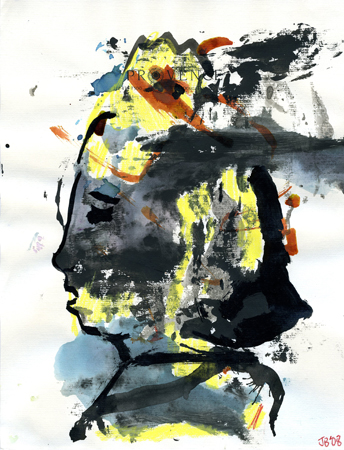Batlle’s Food Fight
Jay Batlle’s art is homage to food of good taste. Yet underneath its savory surfaces Batlle reveals how foodie culture might just be a recipe for financial disaster.
Batlle and his wife Savannah divide their time between Brooklyn and southern France. The thirty-two year old Manhattan-born artist often references sources intended for an amateur urban sophisticate—The New Yorker, the New York Times and the restaurant culture enjoyed by these publications’ relatively high-end readers. He has covered massive canvases with simplified renderings of Géricault, Fragonard, Delacroix or John Singleton Copley, painted over with silk-screened passages from Mark Bittman’s New York Times culinary column, “The Minimalist.” Using coffee grinds, wine and other food stains, Batlle turned a cloth napkins into a series of satirical drawings inspired by the characters in vintage New Yorker cartoons.
Batlle’s “Credit Sharks” are an extensive series of dog tags and surf boards adorned with 24k gold-plated handcuffs and cut-up credit cards to represent the debt incurred by living beyond one’s means in a city like Manhattan. Fashion aristocrat Tallulah Ormsby-Gore, Batlle’s muse and frequent creative collaborator, was just featured in French Vogue handcuffed to a “Credit Shark.” She is attracted to the sillier side of Batlle’s biting satire. “It’s got emotion—there’s humor and action. That’s why I like it,” declares the Lee Strasberg-trained Shakespearian actress and daughter of Lady Amanda Harlech. “But I wish I were more of a starring role in his work: I want to take the prized place of the food that’s in each painting.”
That displacement is yet to come. “Restaurant/Restaurant” (2008) Batlle’s new series of drawings on display at the office gallery at the Art Finance Partners space, a specialty finance company located in the Manhattan’s historic Fuller Builder gallery complex, continues his homage to food. Painted on an assortment of restaurant stationary and pages gleaned from vintage Gourmet magazines, these drawings amply illustrate his belief that good eating and living are great unifiers. “Whatever the creed, class, or language, the viewer can somehow relate to the work’s basic themes or formal structures, because it comes out the ritual of consuming and preparing food on a daily basis,” he says. “It’s something that everyone does on some level every day, or has someone do for them. It’s about living, well.” Since “Credit Sharks” was made from 2003–08, at least Batlle isn’t eating crow, like the rest of us.







